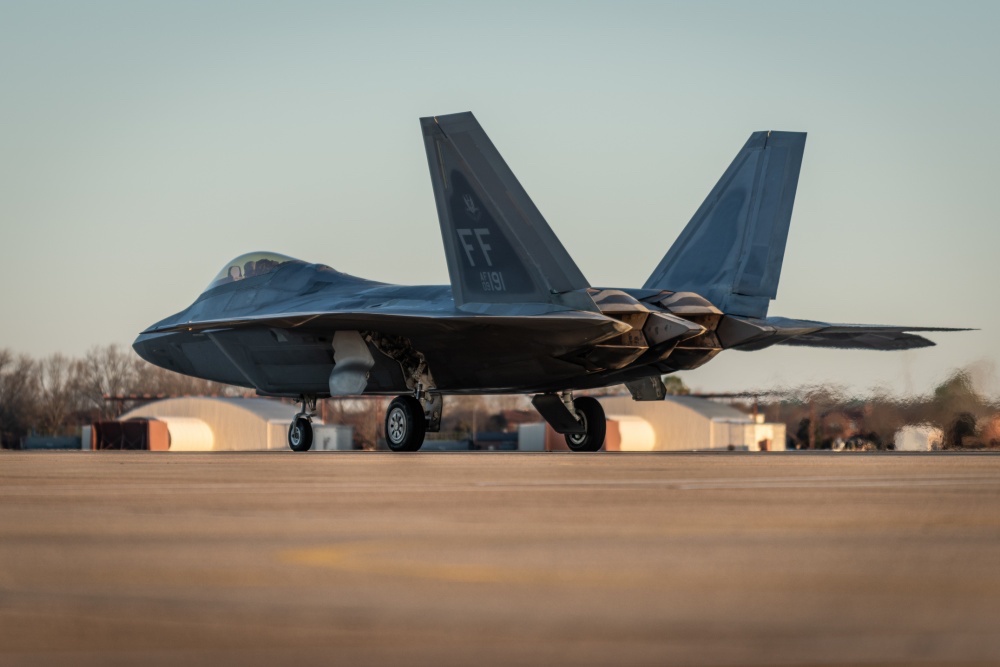WASHINGTON – Three days before an F-22 suffered landing gear problems and crashed during training, a Government Accountability Office’s report found the Department of Defense should prioritize making the jet reliable and safe to fly.
The F-22 Raptor was one of seven acquisition programs, including the F-35 Lightning II and the Joint Light Tactical Vehicle, that prioritized schedule and cost over incorporating crucial reliability practices which resulted in the systems not being as reliable as promised, according to the report.
The F-22 program, a critical component of the Air Force Global Strike Command’s mission to conduct nuclear deterrence and global strike operations, did not have a program leader responsible for reliability and maintainability “because it was not a focus area;” pursued unrealistic reliability requirements as it didn’t adapt well to new technologies like stealth and integrated avionics; and deferred hundreds of known reliability issues identified during design and development until after reliability problems started.
“Without senior leadership focus on a broader range of key reliability practices, DOD runs the risk of delivering less reliable systems than promised to the warfighter and spending more than anticipated on rework and maintenance of major weapon systems,” the report found.
One of the biggest challenges for the F-22 is repairing it to remain invisible to radars, as minor wear and tear will make the aircraft visible to hostile radars, which would defeat the main purpose of the aircraft, said Loren Thompson, a defense analyst at the Lexington Institute.
“If there are two pieces of the airframe that do not fit together perfectly, the seam can reflect radar energy and reveal its location,” Thompson said.
The small fleet of F-22s – about 180 – makes it harder to maintain the aircrafts, Thompson said, because parts to fix the fighter are harder to find.
In 2019, Lockheed Martin, received a $7 billion five-year contract to continue its F-22 repair operations, which mainly focus in repairing the stealth coatings that are damaged.
Lockheed Martin did not answer to a request to comment on the agency’s maintenance job on the F-22.
Since 2010, operational issues in the F-22 have grown, causing accidents during training operations, a Congressional Research Service report found. Since, the Air Force has recorded at least 25 “physiological incidents” of F-22 pilots reporting oxygen deprivation while flying.
On Jan. 16, during routine training at Joint Base Langley-Eustis, an F-22 Raptor experienced a landing accident caused by an unspecified landing gear issue. The pilot did not have to eject but was taken to the base’s hospital as part of standard procedure. An investigation is ongoing.
In 2018, an F-22 made an emergency landing at Joint Base Elmendorf-Richardson in Alaska after the pilot, who didn’t suffer major injuries, realized there was a landing gear malfunction.
In 2012, an F-22 crashed a quarter mile east of Tyndall Air Force Base’s runway after a chafed electrical wire led to an internal fire and caused the pilot to eject shortly before the jet crashed. The F-22 was the second of its kind that same year to crash at the base.
Resuming production of the F-22 would make the fleet easier to maintain, said Tony Levinson, an F-22 and F-35 crash recovery maintainer for over 10 years.
“Airplanes break all the time, even civilian aircraft,” Levinson said. “The F-22 is kind of like a flying laptop, so it’s going to be sensitive to anything: your environment, all that kind of stuff.”
Levinson said the biggest constraint with maintaining F-22s was working with the auxiliary power unit, which provides energy to start the jet. The most common problems he remembers fixing were the unit overheating and shutting down.
Both Levinson and Thompson agreed the Air Force should continue using the fighter jet until 2045 as projected, though Thompson said the jet could fall behind technology-wise in the years to come.
“There is no question the F-22 can keep operating until 2045 – the question is what will it cost and what counters will enemies develop between now and then,” Thompson said. “The value of the F-22 resides in how hard it is to detect, so if enemies come up with new ways of tracking it, then the Air Force will have to respond with upgrades.”
Thompson said “it’s very unlikely the Air Force could find the money” to follow through with the upgrades.
Ann Stefanek, Air Force chief of media operations, said the service plans to continue modernizing the F-22 “to maintain air superiority against evolving threats” but didn’t elaborate on a specific plan.

